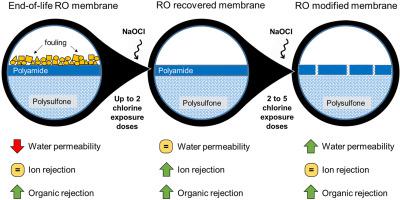Journal of Membrane Science ( IF 8.4 ) Pub Date : 2021-09-21 , DOI: 10.1016/j.memsci.2021.119897 Bianca M. Souza-Chaves 1, 2 , Mohammed A. Alhussaini 1, 2 , Varinia Felix 1, 2 , Luke K. Presson 1, 2 , Walter Q. Betancourt 2, 3 , Kerri L. Hickenbottom 1, 2 , Andrea Achilli 1, 2

|
Numerous efforts have been made over the years to extend the lifespan of reverse osmosis (RO) membranes. End-of-life RO membranes are periodically replaced and usually disposed of in landfills. Periodic membrane modification using chlorination may be an alternative to recover their productivity without compromising membrane characteristics. In this research, RO membranes from an engineering-scale ultrafiltration-RO system treating reclaimed water were exposed five times to 2000 ppm-h of chlorine immediately after chemical cleaning. Water, conductivity, ion, and organic permeability coefficients and rejection were related to the chlorine dose. The breakthrough of six naturally occurring viruses with different levels of persistence to wastewater treatment was also monitored. After five chlorine doses, the apparent water permeability was recovered to 1.0–1.5 L m−2 h−1 bar−1, a 3.1-fold increase compared to the end-of-life membranes, with only a 2% decrease in observed salt rejection. Interestingly, apparent conductivity and ion permeability slightly decreased after the first and second chlorine dose, likely because the chlorine removed irreversible fouling/scaling and thus reduced concentration polarization. After the third chlorine dose, as the RO membrane surface oxidized, more monovalent ions permeated through the membrane, while observed divalent ion rejection remained relatively high and constant (>97%). Similarly, the RO permeate total fluorescence intensity decreased between end-of-life membrane and the second chlorine dose, followed by an increase after the third dose, and only low molecular weight substances (<1 kDa) were detected. All viruses were below or near the detection limit, indicating that oxidation did not compromise the integrity of the membrane in its ability to reject virus-sized particles. The results suggest that targeted chlorination may extend RO membrane lifespan by increasing apparent water permeability while maintaining RO-like selectivity.
中文翻译:

使用氯化延长水回用反渗透膜的使用寿命
多年来,人们做出了许多努力来延长反渗透 (RO) 膜的使用寿命。报废的 RO 膜会定期更换并通常在垃圾填埋场进行处理。使用氯化进行定期膜改性可能是一种替代方法,可以在不影响膜特性的情况下恢复其生产力。在这项研究中,工程规模的超滤 RO 系统处理再生水的 RO 膜在化学清洗后立即暴露于 2000 ppm-h 的氯中五次。水、电导率、离子和有机渗透系数和截留率与氯剂量有关。还监测了对废水处理具有不同持久性的六种天然病毒的突破。五次氯气后,−2 小时−1巴−1,与寿命终止的膜相比增加了 3.1 倍,观察到的盐截留率仅降低了 2%。有趣的是,在第一次和第二次氯气剂量后,表观电导率和离子渗透率略有下降,这可能是因为氯气去除了不可逆的污垢/结垢,从而减少了浓差极化。在第三次氯气剂量后,随着 RO 膜表面氧化,更多的单价离子渗透通过膜,而观察到的二价离子截留率保持相对较高且恒定 (>97%)。类似地,RO 渗透物总荧光强度在寿命终止的膜和第二次氯剂量之间降低,然后在第三次剂量后增加,并且仅检测到低分子量物质(<1 kDa)。所有病毒都低于或接近检测限,表明氧化不会损害膜排斥病毒大小颗粒的能力的完整性。结果表明,靶向氯化可以通过增加表观水渗透率同时保持类似 RO 的选择性来延长 RO 膜的寿命。









































 京公网安备 11010802027423号
京公网安备 11010802027423号